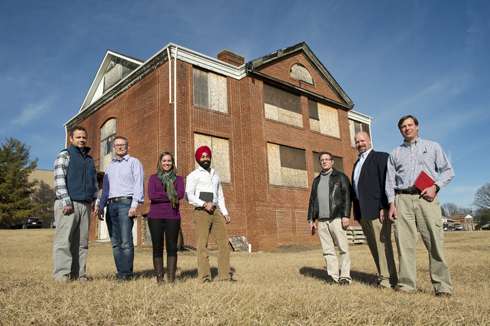New mobile app uses augmented reality to enhance learning experiences at historic sites

Virginia Tech researchers are testing a new mobile software app that will allow school children visiting historic sites to learn in new, interactive ways via augmented reality.
The app will use augmented reality—where the user's view of the real world is enhanced with additional objects and information on a viewing screen—to give students the ability to "see" a historic structure as it appeared decades ago through the camera lens of a smartphone or tablet. Users can explore the site and examine various objects as would a historian, looking for points of historical interest.
Further, children using the app will be able to read historic documents, view photographs, and listen to audio such as oral history interviews related to the location they are visiting. Students then can later analyze the material using a set of guiding questions, according to the app development team which encompasses Virginia Tech's College of Engineering and College of Liberal Arts and Humanities, in addition to the Technology-enhanced Learning and Online Strategies program.
"The goal is to use technology to help secondary school students learn how to use evidence to build an interpretation of the past," said David Hicks, associate professor of history and social science education. He likens young users of the education app to taking on the role of "junior history detectives," tracking historical clues and building a story of what happened in the past.
How does the app work? It takes historic photographs, film, or other media and overlays them on the view screen of the smart mobile device as the user holds it up to an historic building or to a now empty landscape where a structure once stood. The phone's built-in camera, GPS, and other sensors allow the app to identify what or where the user is looking, so that users can see how a historic building and its surroundings looked decades ago, or they can see razed buildings digitally appear where they once existed.
"It's a new way to study history, to become a historian," said Doug Bowman, a professor of computer science. Bowman is leading the augmented reality and user interface aspects of the project.
To prototype the app, the team chose the local Christiansburg Institute site, a historic African-American school in Christiansburg, Va., which prospered for more than a century following the Civil War. Now, only a few of the buildings on what had been a 180-acre campus remain. Culling old photographs, the app gives users the chance to "explore" buildings no longer standing while also providing access to previously inaccessible historical sources on site, or see inside the now boarded-up Edgar A. Long building.
User trials at the site – with local fifth-grade schoolteachers from the Montgomery County Public School system, and Virginia Tech graduate students – are planned for fall 2014. Development of the app is funded by the National Science Foundation for $549,000 during a two-year period.
"This app is meant to guide the student through a historic site and the process of asking questions and learning in much the same way that a teacher or docent would, but with the capacity to allow the user to instantly link to multiple historical sources, serve them up, and save them for later analysis," said David Cline, an assistant professor of history.
The idea for a virtual history app as a learning tool came from the combined efforts of Hicks, Todd Ogle, a senior director with the Technology-enhanced Learning program, and Eric Ragan, now a researcher at Tennessee's Oak Ridge National Laboratory, while he was a computer science doctoral student at Virginia Tech. At the time Ragan was writing his dissertation on educational virtual environments and obtaining information through on-site learning. Each seeking an interest in using augmented reality to view historical content in the context of the real world, the trio soon brought in Bowman and Cline.
"The augmented reality application is exciting, but the project is about more than just making a slick educational tool," said Ragan. "It's about studying new and effective ways to teach people to think critically and evaluate evidence."
Further, leaving a historic site does not mean the end of learning, said Bowman, as the team is devising curriculum material to be used before and after site visits. "Students could use the mobile device to collect, annotate, and organize data at the local site, and then explore, manipulate, and analyze the data in the classroom."
Designed to serve as a model for future apps, the platform could reshape historic tourism, leaving behind static signage or prerecorded digital audiotapes, making the experience of visiting landmarks an interactive, evolving experience for adults and students alike. The app also could find use in such fields as solving engineering problems, as well as the humanities and creative endeavors, such as art museums.
"I do see this being how we all interact with historic sites in the future; hopefully the near future," said Ogle, adding that smaller research projects and commercial projects that use similar virtual apps for tourism are starting to emerge in various fields.
Provided by Virginia Tech




















